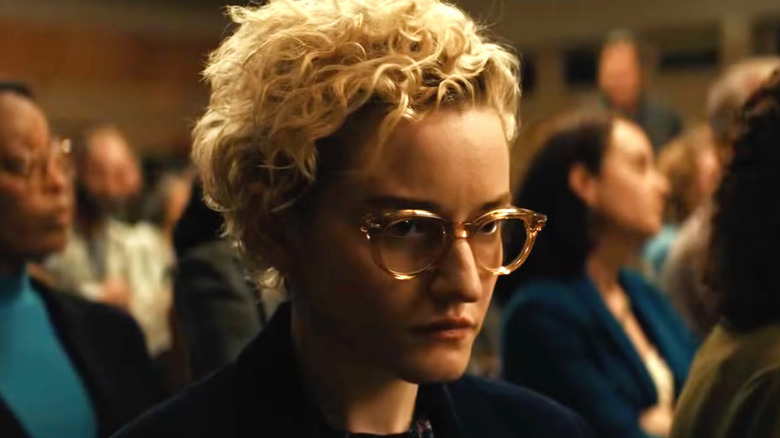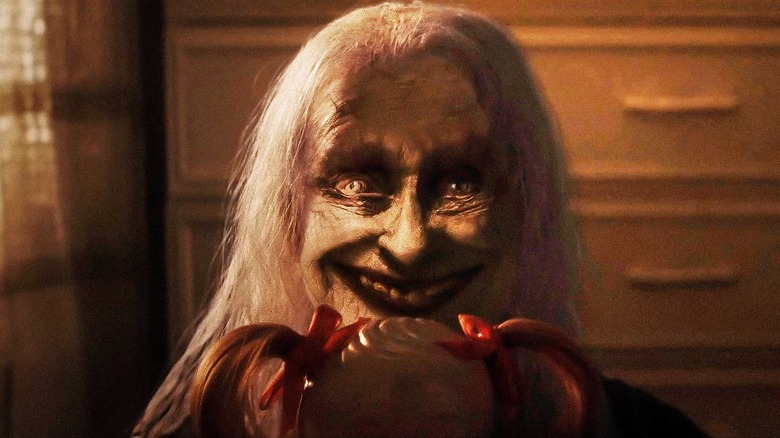Jason Blum Thinks Sinners And Weapons' Success Actually Showcases A Major Horror Problem
2025 has seen the release of two enormously popular original horror films in the form of Ryan Coogler's jazz-era vampire music movie, "Sinners," and Zach Cregger's witchcraft-in-the-suburbs flick "Weapons." Between the pair, "Sinners" was the more expensive, costing $100 million to produce compared to a more modest $38 million for "Weapons." All the same, they were both astonishingly successful at the box office, especially for horror films not based on any established intellectual properties. Another notable horror success from this year was Michael Chaves' "The Conjuring: Last Rites," which brought in nearly half a billion dollars. However, that film was both the fourth mainline entry in the "Conjuring" franchise and but one of the many movies in the broader, interconnected "Conjuring" cinematic universe.
One might be tempted to say that "horror is back, baby," but really, horror has never left. It's the one genre that remains persistent throughout Hollywood history and tends to make money for the studio. "Sinners" notwithstanding, it usually doesn't take a lot of money to make an effective, audience-startling horror flick, and the general public is always thirsty for fear. 2025 is only an aberration in that two notable, original horror films have made so much money.
Jason Blum, the head honcho of the low-budget horror studio Blumhouse, has a different — and perhaps controversial — view on "Sinners" and "Weapons." While their success is certainly impressive, he feels that they represent a general contraction of horror. Speaking to GQ, Blum argued that two major horror successes in a single year is down from five or six in years past. To Blum's eyes, there used to be a lot more cultural penetration with horror, and that "Sinners" and "Weapons," while damn fine movies, are indicators that everything is shifting around for the worse.
Jason Blum misses when there were even more yearly horror success stories
Blum may be recalling his own studio's late-2000s glory days, when a film like "Paranormal Activity" could make over $192 million on a $200,000 budget. Or when "Insidious" raked in over $100 million on a $1.5 million budget. Similar numbers came from "Saw" back in 2004, and that launched a low-budget, high-profile franchise that released one sequel a year for seven straight years. 2013 saw the release of James DeMonaco's "The Purge," another notable low-budget ultra-success that launched a series of sequels. The following year gave us "It Follows," "A Girl Walks Home Alone at Night," "The Guest," "Under the Skin," "The Babadook," and "Oculus." These were all either box office hits or caused a considerable stir among critics and horror fans. Heck, the first "Terrifier" was as recent as 2016.
2025 is a far cry from that time, Blum said. "To have a year where it looks like there are only going to be two original horror movies that broke out into the culture is a new thing," he noted. "Usually there are five or six." 2014 bears that out. He said that there are successes — "Last Rites" was a prime example, as is "Final Destination: Bloodlines" — but that there are now more bombs than hits. The same amount of ticket revenue, he said, is going to fewer movies.
Moreso, though, Blum hated the modern state of movies regarding streaming. He, like many of us, recalls the old-world structure of film releases, wherein a feature film would play in theaters for as long as it needed to, many months would pass, and only then would the film be made available on cable TV or on physical home video formats. With modern streaming, the windows between theatrical releases and streaming releases have gotten smaller or been eliminated entirely.
Jason Blum thinks release windows are too short
Blum said that modern release windows are confusing and that there doesn't seem to be a common release standard. This has left filmgoers confused or disconnected from the modern marketplace, not knowing what was coming or when. In his words:
"You know, some things are on [streaming] in two weeks, some are three weeks, some are four months. Movie theaters have successfully competed with home viewing since the advent of television in the 1950s, but there was always a very clear delineation. Everyone was on the same page: The movie shows first in the movie theater, and months later, you can watch it at home. Now, every window is different. You know, Apple goes off day-and-date, or they don't even do a theatrical. I think it's created confusion in the marketplace."
Blum wistfully remembers a time, not too long ago, when families would leave the house and go to the movie theater without having selected what movie they were going to see. Many filmgoers of a previous generation just liked the movie experience and would select their feature only once they arrived at the box office. Having worked at movie theaters for many years, I can attest to the accuracy of this. Blum misses that era and points out that the new filmmaking model is more "event" based. Only larger phenomena can make huge money. Little films are less likely to be organically discovered with the streaming confusion. He continues:
"Now, when people go to the theater, they're going to see a specific movie. Generally, it's like [the audiences] says, 'You know, that looks kind of cool. I'm sure it'll be at home in a few weeks.' Unless it's, 'Oh, my God, I have to see that in a movie theater.' That's what happened with 'Sinners.' That's what happened with 'Weapons.' And that's what happened with 'The Conjuring.'"
Successes still appear, but he's right. The numbers are kind of down across the board.


